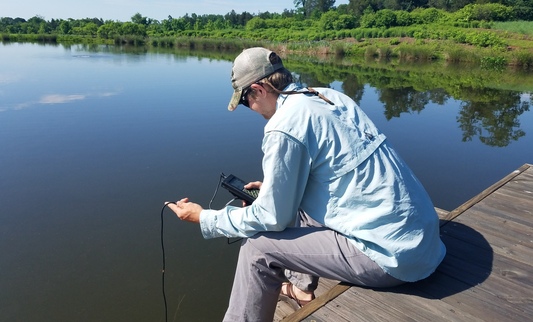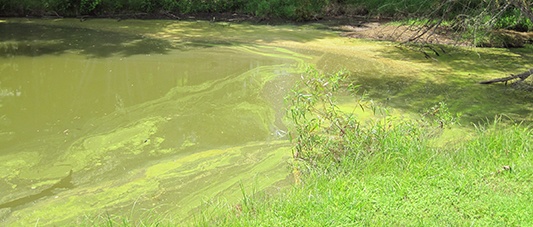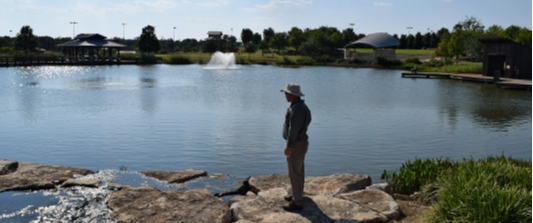Citizen Scientists: Using Your Smartphone to Enhance Lake Stewardship
May 1st, 2019

Written by Amanda Mahaney, Freshwater Biologist
Understanding water as a finite natural resource has defined a century long debate about how to use it, maintain it, preserve it and protect it. Yet, despite these efforts, water quality has continuously declined across the country. Urban development near waterbodies often imparts negative impacts, such as nutrient loading and the spread of nuisance or invasive species. In order to solve a problem, lake management professionals first diagnose and document it using established procedures, but with poor environmental conditions on the rise, scientists cannot be everywhere at once.
Enter your smartphone. With the goal of better engaging and utilizing the knowledge and interests of citizens around the globe, multiple organizations have developed smartphone applications to report water quality problems in their local communities. These efforts were based on the understanding that the general public may possibly be the missing link to reaching all fresh water sources in any given area. With everyday access to smartphone technology, connecting the public to the efforts of environmental groups may provide a large amount of data currently unaccounted for—and it’s as easy as snapping a photo with your iPhone:
Lake ObserverLake Observer is a free app (available for apple and android devices) that is intended for all interested persons to become involved in gathering observations for a waterbody of their choice. Lake Observer was designed by the Global Ecological Observatory Network (GLEON) with convenience and spatial extent in mind. GLEON’s main objective is to create an accessible database to record water quality data across the globe using smartphones. Observations can be collected on any day, at any time of the year. Measurements to be collected include secchi-disc depth, ice cover, air temperature, precipitation/cloud cover, wind speeds, plant species, and algae. All data submitted to Lake Observer is sent to citsci.org (Citizen Science) with an email alert to the state of submission.
Cyanoscope Monitoring Collaborative (CMC)Water quality is currently a highly relevant topic in regards to blue-green algae. Certain species of blue-green algae, or cyanobacteria, have the potential to release toxic compounds. When present in large quantities, a variety of toxins could be harmful to humans and animals alike, and these events are referred to as harmful algal blooms (HABs). Cyanobacteria feed off the overabundance of available nutrients (phosphorus and nitrogen) often associated with waterbodies experiencing excessive nutrient loading. Each year, HABs across the United States in both marine and freshwater environments catch the attention of local or national media. As a result, interested groups (government agencies, Boards of Health, academic researchers, citizen scientists, professional consultants, etc.) have joined forces to form a workgroup referred to as the Cyanobacteria Monitoring Collaborative.

A subset of the CMC workgroup, led by the Environmental Protection Agency, developed a three-tier platform to provide multiple levels of involvement for all interested persons in the quest for healthier water. Within this program, willing participants can collect observations via smartphone, collect water quality samples, or go as far as analyzing water samples for the presence of cyanobacteria.
Tier 1: Bloom Watch is a free app (compatible for apple and android devices) that can be found in your smartphone’s app store. It was developed to enable lay people and citizen scientists, to report potential cyanobacteria blooms, providing rapid information on when and where HAB events are occurring, or can potentially occur. Observations collected on Bloom Watch are uploaded to a public database at citsci.org, a collaborative crowdsourcing website that is designed to promote efforts between citizen scientists, professionals, and government organizations to address local, regional, and global issues.
Tier 2: CyanoScope uses available tools and technology for citizen scientists to collect water samples to monitor for HABs. Participants are trained and provided algae kits by the EPA to analyze water samples that they themselves collect at the waterbody of their choice. Participants use a digital microscope, provided in the algae kit, to take a photo of the sample(s) they collect. Photos taken by the microscope are submitted to the CyanoScope project in iNaturalist.org. Once submitted, participants can interact with the CyanoScope community and have experts assist in species identification.
Tier 3: Cyanomonitoring is the most involved tier of the CMC program. Citizen scientists and professionals interested in tracking the health of a specific waterbody collect one sample every other week between June and September; algae kits are provided for those interested. Participating in the Cyanomonitoring program can provide details about cyanobacteria population changes throughout the growing season, potentially providing the ability to forecast future blooms. If interested in participating in the Cyanobacteria Monitoring Collaborative, please visit cyanos.org to learn more.
What else can you do to be a steward of water?Now that you know what resources are available to you for lake and pond monitoring, what should you do if you identify an invasive aquatic plant species, nuisance weed infestation, toxic algae bloom, or related water quality problem? First, it’s important to notify local environmental authorities of any harmful or invasive aquatic plant or algae species to ensure the public is educated on prevention strategies and the proper steps can be taken to limit further spread.

Based on the unique characteristics of the waterbody, a professional lake manager can provide an array of sustainable management options. Water quality and other parameters may be sampled to help identify the source of the problem and design a personalized action plan. Water quality testing and monitoring are the backbone of any long-term integrated lake or pond restoration effort, and can pinpoint weaknesses within the waterbody, including excess nutrient supplies, unbalanced pH and poor dissolved oxygen levels. Following water quality tests, your lake manager may recommend strategies to increase beneficial bacteria, improve the chemical balance of the aquatic ecosystem, remove muck and debris from the bottom of the waterbody, or limit the impacts of nutrient loading. These goals may be improved by establishing beneficial vegetative buffers, introducing a floating fountain or nanobubble aeration system, or applying products like Phoslock, Alum or Biochar, which remove phosphorous and nitrogen from the water column.
Government agencies and working professionals understand that they cannot be the sole entities protecting this important resource and that we are all stewards of our natural resources. Today, the modern technology available to all people can engage and connect all willing participants to the task of preserving the health of our oceans, lakes, rivers and ponds, together. Through science, education, a smartphone and sustainable management tools, anyone can rise to the occasion of ensuring that the water they enjoy recreationally will remain healthy and available for generations to come.
Contact the experts at 888-480-5253 for all of your lake, stormwater pond, wetland and fisheries management needs.
 Amanda Mahaney is an aquatic biologist, living out her childhood dream to work with freshwater ecosystems. She graduated from Anna Maria College in Paxton, MA in 2012, earning her Bachelor of Science degree in Environmental Science. Amanda helps clients develop and achieve environmentally sustainable goals for their aquatic ecosystems. She has a special interest in GIS data collection and map preparation, and enjoys educating the public about the importance of land preservation.
Amanda Mahaney is an aquatic biologist, living out her childhood dream to work with freshwater ecosystems. She graduated from Anna Maria College in Paxton, MA in 2012, earning her Bachelor of Science degree in Environmental Science. Amanda helps clients develop and achieve environmentally sustainable goals for their aquatic ecosystems. She has a special interest in GIS data collection and map preparation, and enjoys educating the public about the importance of land preservation.
SOLitude Lake Management is a nationwide environmental firm committed to providing sustainable solutions that improve water quality, enhance beauty, preserve natural resources and reduce our environmental footprint. SOLitude’s team of aquatic resource management professionals specializes in the development and execution of customized lake, stormwater pond, wetland and fisheries management programs that include water quality testing and restoration, nutrient remediation, algae and aquatic weed control, installation and maintenance of fountains and aeration systems, bathymetry, shoreline erosion restoration, mechanical harvesting and hydro-raking, lake vegetation studies, biological assessments, habitat evaluations, and invasive species management. Services and educational resources are available to clients nationwide, including homeowners associations, multi-family and apartment communities, golf courses, commercial developments, ranches, private landowners, reservoirs, recreational and public lakes, municipalities, drinking water authorities, parks, and state and federal agencies. SOLitude Lake Management is a proud member of the Rentokil Steritech family of companies in North America.










